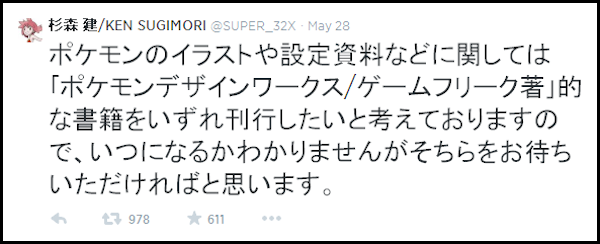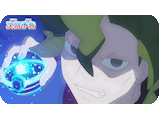
A 25 Year Portfolio from "Quinty"
to "Jerry Boy" & "Pocket Monsters"



Main
Old Updates Archive
Links
 |
Lists |
List of Pokémon
Pokémon World Atlas
List of Techniques
List
of Items
List of TV Episodes
 |
Guides |
Episode Comparisons
Movies
& Specials Guide
CD Guide
DVD Guide
Voice
Actors Guide
Lyrics Archive
Manga Guide
Video
Games
 |
Miscellaneous |
Humor
Pokémon Bashing
Features
Rants
Dogasu's
Backpack
| Features
| Ken Sugimori Works

On May 27th, 2014, publisher Nintendo Dream released a portfolio of Ken Sugimori (杉森健), the man most of us know as being responsible for the official artwork used for the main series of Pocket Monsters games. The title of the book is Ken Sugimori's Work - A 25 Year Portfolio from "Quinty" to "Jerry Boy" and "Pocket Monsters" (杉森建の仕事 『クインティ』から『ジェリーボーイ』『ポケットモンスター』 25年間の作品集).
This page will look at this Japanese language book and what it contains that's of interest to us Pocket Monsters fans.
A lot of biographers will interview the subjects of their upcoming books and then use the information they've gathered to write up their story in prose form. Ken Sugimoris Work - A 25 Year Portfolio from "Quinty" to "Jerry Boy" and "Pocket Monsters" takes a different approach. Here, the interview is presented as-is, broken up into various sections and spread throughout the book.
The 32-page interview starts off the standard types of questions you'd expect a biographer to ask. "When were you born?" "Where were you born?" "What is your first memory?" Things like that. The interview goes through Mr. Sugimori's childhood, more or less chronologically, starting from the time he was doodling comics in elementary school to when he first met Satoshi Tajiri and joined Game Freak. We learn what kind of comics and cartoons he read as a kid, how he used to draw a bunch of gag manga as a kid (including a Space Battleship Yamato parody called Space Battleship Tomato), his short-lived aspirations to be an animator, how he made his manga debut in Weekly Shonen Sunday when he was still in high school, how he got interested in video games, etc. Some of this information has been readily available online for years now but a lot of it seems to be brand new.

Mr. Sugimori eventually met Satoshi Tajiri, the man who would be credited as going on to create Pocket Monsters, and started working for his video game magazine called Game Freak. Ken Sugimori, naturally, provided the illustrations for the publication. At some point during all this Mr. Tajiri decided that they should actually make their own video games instead of simply writing about them and so the two of them recruited others to help them make this dream a reality.
The first game the company would make would be Quinty (released in the U.S. as Mendel Palace), an action puzzle game that took them nearly three years to finish. The game became a surprise success that enabled Game Freak to evolve into Game Freak Inc. The company's next game was Jerry Boy (Smart Ball in the U.S.).
Game
Freak would continue making games, and Ken Sugimori would continue
providing the artwork for them. There
was Magical Taluluto-kun (まじかる☆タルるートくん), a
video game based on the then-popular manga series; Pulseman, a Mega Drive game
that was later made available on the Wii Virtual Console; Bushi The
Legend of the Blue Dragon and the Two Heroes (BUSHI
青龍伝~二人の勇者~),
an RPG;
and Screw Breaker Roaring
Rumble! Dri-ru-re-ro (ス
クリューブレイカー
轟振どりるれろ), released in the U.S. as Drill
Dozer. There's also a page devoted to the aborted
sequel
to Jerry Boy called Jerry Boy 2. There are other
games that Game Freak made that aren't included in this book (Yoshi, Wario's Woods, etc.) but
that's probably because Mr. Sugimori didn't have anything to do with
any of them.
The sections for each of the games covered contains sketches Mr. Sugimori did for them during various stages of development. For the Quinty section, a manga he drew to promote the game that ran in the magazine Famicom Ensured Victory Book (ファミコン 必勝本) back in 1990 is reprinted here for the first time in 24 years. Likewise, the manga he drew for the game Jerry Boy, this time for Family Computer Magazine (ファミリーコンピュターマガジン) back in 1991, is reprinted. Other manga he worked on while making games at Game Freak include The New "Sorry for Causing You Trouble" (新・毎度おさわがせします), a manga version of a TV drama airing at the time; and The New Adventures of Valkyrie ~ The Two Goddesses ~ (ワルキューレの冒険外伝~ふ たりの女神~), a manga based on a popular Famicom game put out by Namco.
He's also done artwork for the "Sega Arcade History" (セガ・アーケードヒス トリー), a feature that ran in the magazine Mega Drive Fan (メガドライブFAN), as well as art for various other projects such as a series of pachinko books and the player's guide for the Super Famicom Lemmings video game.
Oh yeah, and he also worked on something called Pocket Monsters.
Before the Pocket Monsters section starts off proper, this image, which I'm sure a lot of you have already seen online at some point, is randomly printed off on a page all to its own:

The text that accompanies the image is quite interesting:
Many Pokémon fans had assumed that this image was prototype artwork for future Pokémon games -- two of those clearly look like Bangiras and Protoga -- but it looks like that wasn't the case at all! This was just a fun "what if" image Mr. Sugimori whipped up for a game magazine back in 1997 that just happens to feature designs that would later be recycled for the main series Pocket Monsters games.
Once we actually get to the section dedicated to Pocket Monsters we're greeted by a paragraph-long overview of the franchise that explains how Mr. Sugimori has been in charge of doing the official illustrations for all the Pokémon since the Red & Green days. He was also in charge of drawing the human characters in the first games and has also done work for some of the characters in the TV series and movies.
The next nine pages show the official Sugimori artwork for a number of human characters and Pokémon, all of which can already be found on fansites without any problem. There are about four Pokémon per page and all of the artwork on display is from the FireRed / LeafGreen era. Some of the comments next to the images are next to useless ("Koduck was designed with the idea that it's always suffering from a headache") but not all of them are so bad. Here are the highlights:
(By the way, the book doesn't print show the stern faced 1996 design for Dr. Ookido, but here it is for your reference)
Mr. Sugimori later went on Twitter to clarify this particular entry:
(The staff member that Kabigon is based on is Kouji Nishino (西野弘二), though this piece of information isn't noted anywhere in the book)
Next up is the section of the 32-page interview that goes into Pokémon. He states that while he's no longer in charge of doing the artwork for all the human characters anymore, he's still the one responsible for drawing the official artwork for all the Pokémon. He then says that when he was first assigned to do the artwork for the Pokémon back in the Red & Green days it was for the official guide books that going to go on sale soon. The only artwork that existed at the time were the sprites that had been ripped from the games and so Mr. Sugimori had to go through all that pixel art, one by one, and draw the Pokémon based on these sprites. During this time he would change parts of the Pokémon he didn't like for whatever reason. The book doesn't expand on this at all, but I imagine he's talking about things like the position of the skull and crossbones on Dogars' body or how Fushigisou stands on four legs instead of two. Mr. Sugimori tells us that his job is to basically give the series a uniform style so that the fact that all the Pokémon are designed by so many different people with their own different art styles isn't quite so obvious.
The interviewer starts to ask Mr. Sugimori about various things from his childhood -- when he figured out he could live off his artwork, what he thinks about the importance of game art today vs. back when games were first becoming a thing, etc. -- before coming back to Pokémon. Ken Sugimori tells the interviewer that he still draws the outline with a pen on actual paper but that these days he'll scan them into a computer and then color the images digitally. The interviewer asks if he's against doing his artwork paperless, and Mr. Sugimori responds that he's not really against it, per se, but that he prefers the sensation of feeling the paper as he works. He also feels that digital artwork is too clean and likes the imperfections that come with doing his artwork by hand; he talks specifically about how he likes how the lines in his artwork appear "dirty" whenever it gets enlarged. He realizes that there aren't a lot of people left in the business who feel the same way.
He then talks about how he'll do research on various Pokémon before drawing them. If he's working on a bird Pokémon, for example, he'll study real birds' skeletons and wings to avoid drawing something out of place and embarrassing himself. He can fudge with some things, of course, but for the most part he tries to keep the key parts of the Pokémon accurate to its real life counterpart. Mr. Sugimori also talks about having to do research for the human characters, saying that if someone is supposed to dress a certain way he'll have to go out and study a bunch of fashion magazines to make sure everything looks right.
After answering a bunch of questions about being the most senior member of Game Freak's art staff ("What I have over the younger staff members is experience"), he's asked about the last manga he worked on. He recalls that the last one he did was a Pokémon Mysterious Dungeon manga for a special pre-order guide book that was released back in 2007.
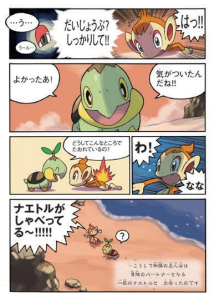
The next two pages are dedicated to showing off the box art of all 23 of the main series Pocket Monsters games, all of which were drawn by Mr. Sugimori using pen and paint. The next four pages show various art he's done for the "Pokémon Collectible Art PG" series.
Did that Pocket Monsters section seem short to you? Is Dogasu being lazy and skipping over large parts of the book?
Unfortunately no, I am not. This is a 360 page book. While Pocket Monsters is mentioned a few times here and there in the early parts (for example, he talks about working on Drill Dozer and how, as grateful as he is for the success that the Pocket Monsters games have brought them, it was nice to work on something else for a change), the actual Pocket Monsters section of the book doesn't start until Page 329. By page 350 the book goes back to being about Ken Sugimori and what TV shows he likes. In other words, only about 20 pages of this 360 page book are dedicated to Pocket Monsters, and of those 20 pages nearly half of them is stuff you can find online barely any effort at all.
This is not a Pocket Monsters book. This is a book about Ken Sugimori that's focused on pretty much everything he's done other than Pocket Monsters. But a book like that wouldn't sell and so Pikachu and the Kanto starters were thrown on the cover to get some of the Pocket Monsters crowd to buy it. It's a sneaky strategy that seems to be working.
Look, I get it. Quinty and Jerry Boy are probably very close to Mr. Sugimori's heart, being the first games he worked on and all. And as an artist I'm sure he's extremely proud of the work he did all those years ago. But let's be frank here; none of us would know who the hell Ken Sugimori was if it wasn't for Pocket Monsters. It seems odd to skimp on the only section of this book a significant portion of its audience actually cares about.
Now let's suppose I'm coming at this book as a Sugimori fan and not necessarily as a Pocket Monsters fan. Maybe I really loved Pulseman or something. Well even then I'd wonder what the hell the publishers of this book were thinking. As I alluded to earlier, there are Quinty and Jerry Boy comics reprinted in this book. The Quinty comic takes up pages 38 to 161 while the Jerry Boy one takes up pages 181 to 298, meaning more than half of this book is just manga. Manga that hasn't been collected anywhere else until now, sure, but manga nonetheless. No wonder so many of the reviewers on the book's Amazon Japan page declared that "this is not an illustration collection; this is a comic book."
To his credit, though, Mr. Sugimori has gone on Twitter to address these complaints. Part One:
Part Two:
Part Three:
And finally,
Nintendo Dream could absolutely create a 360-page Pocket Monsters illustration collection that would give us everything we'd want. And maybe they will! But I think it's important to know that this book, right here, is not that.
Ken Sugimori's Work - A 25 Year Portfolio from "Quinty" to "Jerry Boy" and "Pocket Monsters" is a great look at Ken Sugimori the man. It is not such a great look at Pocket Monsters, the reason many of us even know the guy's name in the first place. I don't regret my purchase because there is some interesting stuff in here but if you're someone who has trouble with the language (by the way, there's no furigana over any of the kanji in this thing) and are just buying the book for the pictures then you'll be sorely, sorely disappointed. I wish I could recommend this book more enthusiastically and tell you that yes, this is a must-have for any Pocket Monsters fan, but I just can't.
You can order the book on Amazon Japan, YesAsia, and CD Japan. It retails for 1,850 yen + tax. ISBN 978-4-19-863806-1

On May 27th, 2014, publisher Nintendo Dream released a portfolio of Ken Sugimori (杉森健), the man most of us know as being responsible for the official artwork used for the main series of Pocket Monsters games. The title of the book is Ken Sugimori's Work - A 25 Year Portfolio from "Quinty" to "Jerry Boy" and "Pocket Monsters" (杉森建の仕事 『クインティ』から『ジェリーボーイ』『ポケットモンスター』 25年間の作品集).
This page will look at this Japanese language book and what it contains that's of interest to us Pocket Monsters fans.
| The years leading up to
Pocket Monsters |
A lot of biographers will interview the subjects of their upcoming books and then use the information they've gathered to write up their story in prose form. Ken Sugimoris Work - A 25 Year Portfolio from "Quinty" to "Jerry Boy" and "Pocket Monsters" takes a different approach. Here, the interview is presented as-is, broken up into various sections and spread throughout the book.
The 32-page interview starts off the standard types of questions you'd expect a biographer to ask. "When were you born?" "Where were you born?" "What is your first memory?" Things like that. The interview goes through Mr. Sugimori's childhood, more or less chronologically, starting from the time he was doodling comics in elementary school to when he first met Satoshi Tajiri and joined Game Freak. We learn what kind of comics and cartoons he read as a kid, how he used to draw a bunch of gag manga as a kid (including a Space Battleship Yamato parody called Space Battleship Tomato), his short-lived aspirations to be an animator, how he made his manga debut in Weekly Shonen Sunday when he was still in high school, how he got interested in video games, etc. Some of this information has been readily available online for years now but a lot of it seems to be brand new.

Mr. Sugimori eventually met Satoshi Tajiri, the man who would be credited as going on to create Pocket Monsters, and started working for his video game magazine called Game Freak. Ken Sugimori, naturally, provided the illustrations for the publication. At some point during all this Mr. Tajiri decided that they should actually make their own video games instead of simply writing about them and so the two of them recruited others to help them make this dream a reality.
The first game the company would make would be Quinty (released in the U.S. as Mendel Palace), an action puzzle game that took them nearly three years to finish. The game became a surprise success that enabled Game Freak to evolve into Game Freak Inc. The company's next game was Jerry Boy (Smart Ball in the U.S.).
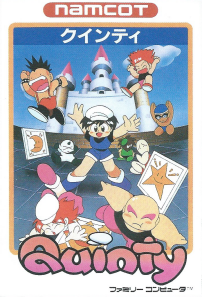 |
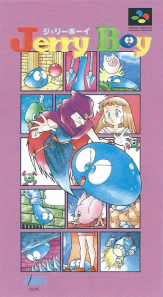 |
The sections for each of the games covered contains sketches Mr. Sugimori did for them during various stages of development. For the Quinty section, a manga he drew to promote the game that ran in the magazine Famicom Ensured Victory Book (ファミコン 必勝本) back in 1990 is reprinted here for the first time in 24 years. Likewise, the manga he drew for the game Jerry Boy, this time for Family Computer Magazine (ファミリーコンピュターマガジン) back in 1991, is reprinted. Other manga he worked on while making games at Game Freak include The New "Sorry for Causing You Trouble" (新・毎度おさわがせします), a manga version of a TV drama airing at the time; and The New Adventures of Valkyrie ~ The Two Goddesses ~ (ワルキューレの冒険外伝~ふ たりの女神~), a manga based on a popular Famicom game put out by Namco.
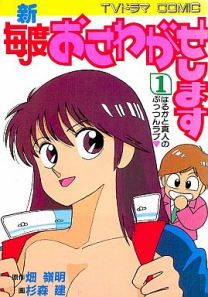 |
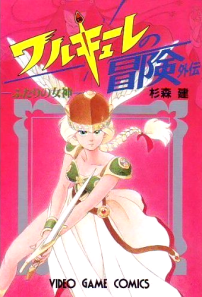 |
He's also done artwork for the "Sega Arcade History" (セガ・アーケードヒス トリー), a feature that ran in the magazine Mega Drive Fan (メガドライブFAN), as well as art for various other projects such as a series of pachinko books and the player's guide for the Super Famicom Lemmings video game.
Oh yeah, and he also worked on something called Pocket Monsters.
| Pocket
Monsters |
Before the Pocket Monsters section starts off proper, this image, which I'm sure a lot of you have already seen online at some point, is randomly printed off on a page all to its own:

The text that accompanies the image is quite interesting:
| "This is an
illustration that was used as the cover for the April 1997 issue of the
magazine Game Review (Micro
Magazine Publishing Company). There was a feature in the magazine
called the "Games That Stand Out Collection" and this color
illustration of an imaginary game title offers an example of the theme
of the article." 1997年に雑誌「ゲーム批評」(マイクロマガジン社)4月号の表紙として掲載されたイラスト。「個性派ゲーム特集」ということで、架空のゲームタイトル をモチーフとして描かれたカラーイラストです。 |
Many Pokémon fans had assumed that this image was prototype artwork for future Pokémon games -- two of those clearly look like Bangiras and Protoga -- but it looks like that wasn't the case at all! This was just a fun "what if" image Mr. Sugimori whipped up for a game magazine back in 1997 that just happens to feature designs that would later be recycled for the main series Pocket Monsters games.
Once we actually get to the section dedicated to Pocket Monsters we're greeted by a paragraph-long overview of the franchise that explains how Mr. Sugimori has been in charge of doing the official illustrations for all the Pokémon since the Red & Green days. He was also in charge of drawing the human characters in the first games and has also done work for some of the characters in the TV series and movies.
The next nine pages show the official Sugimori artwork for a number of human characters and Pokémon, all of which can already be found on fansites without any problem. There are about four Pokémon per page and all of the artwork on display is from the FireRed / LeafGreen era. Some of the comments next to the images are next to useless ("Koduck was designed with the idea that it's always suffering from a headache") but not all of them are so bad. Here are the highlights:
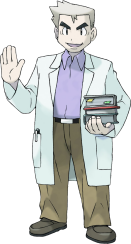 |
 |
| Dr. Ookido "The first character design from around 1996 had a stern look on his face but the later design gave him a more gentle face." |
Takeshi "He was written as someone who doesn't smile all that much and so Mr. Sugimori made the unusual decision to not draw any eyes on him." |
(By the way, the book doesn't print show the stern faced 1996 design for Dr. Ookido, but here it is for your reference)
 |
 |
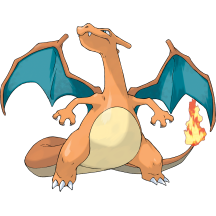 |
| Hitokage → Lizardo → Lizardon "You can see how the flame on the tip of its tail doesn't change size all that much despite the Pokémon itself getting bigger." |
||
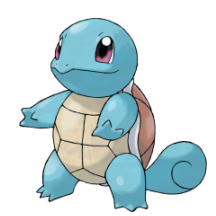 |
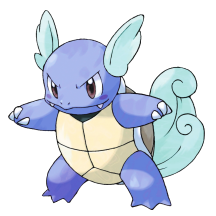 |
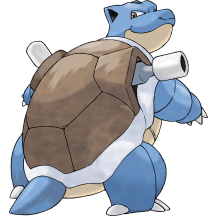 |
| Zenigame → Kameil → Kamex "Pay attention to the tails of both Zenigame and Kameil. The spiral shape gives you a glimpse of what makes Mr. Sugimori's designs so distinctive." |
||
Mr. Sugimori later went on Twitter to clarify this particular entry:
| "The spiral
shape"
was used a lot for the enemy characters in the Mega Drive game Magical
Taluluto-kun and so the part that says that it "gives you a
glimpse of
what makes Mr. Sugimori's designs so distinctive" isn't incorrect (this
can also be seen in the designs of Pokémon like Pippi, Laplace,
and
Yadon). With
that said, however, I'm not the one who actually designed Zenigame and
Kameil." 「渦巻き状の表現」はMD「タルるート」の敵キャラを作った頃から多用してたので「杉森氏のデザインに垣間見られる特徴」という点では間違ってません (ピッピ、ラプラス、ヤドンなどで実際使ってます)が、ゼニガメとカメールに適用したのは俺じゃないです。 |
 |
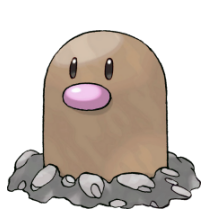 |
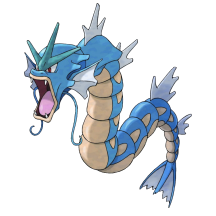 |
| Nyarth "The...I guess you can call them whiskers?...are not drawn like normal hair to make them more interesting." |
Digda "This design is meant to invoke the question "What exactly is underneath the dirt there?"" |
Gyarados "Parts of this Pokémon, like its fins and scales, were simplified in order to conform to the limits of the Game Boy's hardware." |
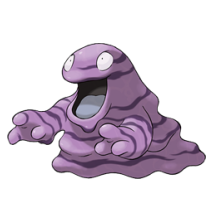 |
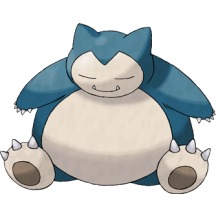 |
| Betobeta "This design gave the Pokémon a wave-like pattern to give the illusion of movement in the animation-free Game Boy games." |
Kabigon "In a rarity for the series, Kabigon was modeled off of one of the members of the development staff." |
(The staff member that Kabigon is based on is Kouji Nishino (西野弘二), though this piece of information isn't noted anywhere in the book)
Next up is the section of the 32-page interview that goes into Pokémon. He states that while he's no longer in charge of doing the artwork for all the human characters anymore, he's still the one responsible for drawing the official artwork for all the Pokémon. He then says that when he was first assigned to do the artwork for the Pokémon back in the Red & Green days it was for the official guide books that going to go on sale soon. The only artwork that existed at the time were the sprites that had been ripped from the games and so Mr. Sugimori had to go through all that pixel art, one by one, and draw the Pokémon based on these sprites. During this time he would change parts of the Pokémon he didn't like for whatever reason. The book doesn't expand on this at all, but I imagine he's talking about things like the position of the skull and crossbones on Dogars' body or how Fushigisou stands on four legs instead of two. Mr. Sugimori tells us that his job is to basically give the series a uniform style so that the fact that all the Pokémon are designed by so many different people with their own different art styles isn't quite so obvious.
The interviewer starts to ask Mr. Sugimori about various things from his childhood -- when he figured out he could live off his artwork, what he thinks about the importance of game art today vs. back when games were first becoming a thing, etc. -- before coming back to Pokémon. Ken Sugimori tells the interviewer that he still draws the outline with a pen on actual paper but that these days he'll scan them into a computer and then color the images digitally. The interviewer asks if he's against doing his artwork paperless, and Mr. Sugimori responds that he's not really against it, per se, but that he prefers the sensation of feeling the paper as he works. He also feels that digital artwork is too clean and likes the imperfections that come with doing his artwork by hand; he talks specifically about how he likes how the lines in his artwork appear "dirty" whenever it gets enlarged. He realizes that there aren't a lot of people left in the business who feel the same way.
 |
| Notice how the thickness of the outline
varies throughout the image. |
He then talks about how he'll do research on various Pokémon before drawing them. If he's working on a bird Pokémon, for example, he'll study real birds' skeletons and wings to avoid drawing something out of place and embarrassing himself. He can fudge with some things, of course, but for the most part he tries to keep the key parts of the Pokémon accurate to its real life counterpart. Mr. Sugimori also talks about having to do research for the human characters, saying that if someone is supposed to dress a certain way he'll have to go out and study a bunch of fashion magazines to make sure everything looks right.
After answering a bunch of questions about being the most senior member of Game Freak's art staff ("What I have over the younger staff members is experience"), he's asked about the last manga he worked on. He recalls that the last one he did was a Pokémon Mysterious Dungeon manga for a special pre-order guide book that was released back in 2007.

The next two pages are dedicated to showing off the box art of all 23 of the main series Pocket Monsters games, all of which were drawn by Mr. Sugimori using pen and paint. The next four pages show various art he's done for the "Pokémon Collectible Art PG" series.
| OK,
here's the thing... |
Did that Pocket Monsters section seem short to you? Is Dogasu being lazy and skipping over large parts of the book?
Unfortunately no, I am not. This is a 360 page book. While Pocket Monsters is mentioned a few times here and there in the early parts (for example, he talks about working on Drill Dozer and how, as grateful as he is for the success that the Pocket Monsters games have brought them, it was nice to work on something else for a change), the actual Pocket Monsters section of the book doesn't start until Page 329. By page 350 the book goes back to being about Ken Sugimori and what TV shows he likes. In other words, only about 20 pages of this 360 page book are dedicated to Pocket Monsters, and of those 20 pages nearly half of them is stuff you can find online barely any effort at all.
This is not a Pocket Monsters book. This is a book about Ken Sugimori that's focused on pretty much everything he's done other than Pocket Monsters. But a book like that wouldn't sell and so Pikachu and the Kanto starters were thrown on the cover to get some of the Pocket Monsters crowd to buy it. It's a sneaky strategy that seems to be working.
Look, I get it. Quinty and Jerry Boy are probably very close to Mr. Sugimori's heart, being the first games he worked on and all. And as an artist I'm sure he's extremely proud of the work he did all those years ago. But let's be frank here; none of us would know who the hell Ken Sugimori was if it wasn't for Pocket Monsters. It seems odd to skimp on the only section of this book a significant portion of its audience actually cares about.
Now let's suppose I'm coming at this book as a Sugimori fan and not necessarily as a Pocket Monsters fan. Maybe I really loved Pulseman or something. Well even then I'd wonder what the hell the publishers of this book were thinking. As I alluded to earlier, there are Quinty and Jerry Boy comics reprinted in this book. The Quinty comic takes up pages 38 to 161 while the Jerry Boy one takes up pages 181 to 298, meaning more than half of this book is just manga. Manga that hasn't been collected anywhere else until now, sure, but manga nonetheless. No wonder so many of the reviewers on the book's Amazon Japan page declared that "this is not an illustration collection; this is a comic book."
To his credit, though, Mr. Sugimori has gone on Twitter to address these complaints. Part One:
| "This was
been
reported several times before the book came out, but this portfolio
(this is not an art book) doesn't have that many Pokémon
illustrations
in it! I suggest those of you who are interested in this book
because of the Pokémon
illustrations and production artwork then please look over
this detailed
breakdown of what's in the book (http://www.nindori.com/books/publications/sugimoriworks.html
… ).
I'll be
happy if you look at that and still decide to buy this book." 発売前に何回か告知しましたが、作品集(画集ではございません)にポケモン関係の絵はあまり収録されてません!ポケモンのイラストや資料が目当ての方は詳 細な収録内容(こちら→ http://www.nindori.com/books/publications/sugimoriworks.html … )をご覧になってからご購入を検討頂ければ幸いです。 |
Part Two:
| "The reason
there
aren't that many (in the book) is because even though I'm the one who
draws the official artwork the actual designs of the Pokémon
themselves are
done by a whole team of people, and on top of that the various ways
people are connected to the designs make it difficult for me to figure
out who did what." 収録数が多くない理由は、「ポケモン公式イラスト」は僕が描きましたが「ポケモンデザイン」は多人数のデザイナーがチームで関わっており、しかもその関わ り方も濃度が様々で純粋に僕の仕事として区別することが難しいからです。 |
Part Three:
| "I've been
told it'd be a pain in the neck to create a "Design Works" based on the
work of multiple artists, and while they didn't outright say "no" they
did say that it'd be a long and arduous job of tracking down each
person in charge of each (design) and explaining what we would want to
do." めんどくさいからって多人数でのデザインワークを否定してるわけではなく個々の担当分について他人に正確に説明するのが困難で手間がかかるということです |
And finally,
| "I hope
there will be
a book collecting Pokémon illustrations and development artwork,
something like a "Pokémon Design Works / Game Freak Works"-type
book,
but I don't know when it'll come out so we'll just have to wait for it." ポケモンのイラストや設定資料などに関しては「ポケモンデザインワークス/ゲームフリーク著」的な書籍をいずれ刊行したいと考えておりますので、いつにな るかわかりませんがそちらをお待ちいただければと思います。 |
Nintendo Dream could absolutely create a 360-page Pocket Monsters illustration collection that would give us everything we'd want. And maybe they will! But I think it's important to know that this book, right here, is not that.
| Final
Thoughts |
Ken Sugimori's Work - A 25 Year Portfolio from "Quinty" to "Jerry Boy" and "Pocket Monsters" is a great look at Ken Sugimori the man. It is not such a great look at Pocket Monsters, the reason many of us even know the guy's name in the first place. I don't regret my purchase because there is some interesting stuff in here but if you're someone who has trouble with the language (by the way, there's no furigana over any of the kanji in this thing) and are just buying the book for the pictures then you'll be sorely, sorely disappointed. I wish I could recommend this book more enthusiastically and tell you that yes, this is a must-have for any Pocket Monsters fan, but I just can't.
You can order the book on Amazon Japan, YesAsia, and CD Japan. It retails for 1,850 yen + tax. ISBN 978-4-19-863806-1
Found an error? Spot an omission? Please help me keep this page current and error-free by e-mailing me with a description of the error or omission.





